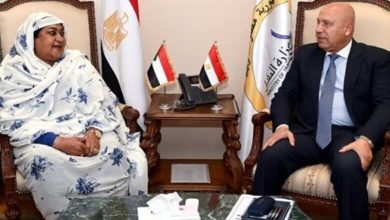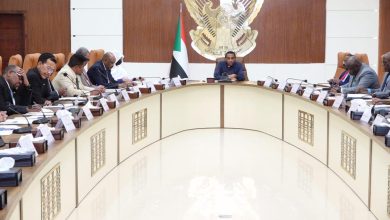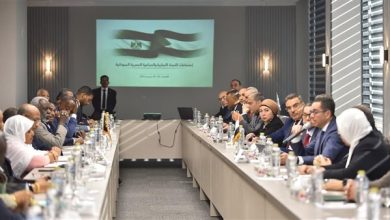Microfinance expert Dr. Noman Youssef reveals to “Al-Ahdath” the sector’s losses: These challenges (…) will face the microfinance sector after the war

Microfinance expert Dr. Noman Youssef reveals to “Al-Ahdath” the sector’s losses:
The poverty rate increased to about 65.6% due to the war
Small and medium enterprise owners leaving the market
These challenges (…) will face the microfinance sector after the war
Dialogue – Nahid Oshi
Entrepreneurship consultant and microfinance expert Dr. Noman Youssef spoke about the decline in investments as a result of the lack of financing and the reluctance of financial institutions to provide loans, which led many owners of small and medium enterprises to leave the market. He pointed to the impact of the war on the microfinance sector, which he considered the most fragile sector, and demanded stopping the war and reaching a comprehensive peace agreement to ensure attracting international support to rehabilitate the destroyed infrastructure, improve the investment environment, and attract foreign investments from donors, regional and international organizations and bodies, while developing a national strategy for microfinance. He touched on many microfinance issues in the following dialogue.
What is the impact of the war on the microfinance sector?
The war that broke out in April of last year cast a negative shadow on all aspects, including the loss of thousands of citizens’ lives and the displacement of more than a third of Sudan’s population, both displaced and refugees. In addition to the looting of money, property, and assets, and the widespread destruction of infrastructure, it affected all sectors, including health, education, culture, tourism, industry, and vital services such as electricity, water, communications, transportation, commerce, and banking, including institutions that provide microfinance services. The wheel of work and production stopped in two-thirds of the states of Sudan, and vital services such as water, electricity, and treatment were lacking, with limited resources and the plundering of citizens’ personal savings.
The poverty rate rose to about 65.6%, and hunger threatened more than 25 million male and female citizens, depriving 19 million male and female students of continuing their studies in schools and universities. In addition to the communications outage and its widespread impact on banking services and money transfer.
Since the microfinance sector is closely linked to all economic and social sectors and is naturally a more fragile sector, its impact was severe and its losses were huge at all levels (macro, intermediate, and micro).
Are there accurate statistics on the impact of the war on the microfinance sector?
Despite the lack of accurate statistics approved by official authorities due to the continuation of the war and the lack of security.
However, the performance indicators of the microfinance sector by the end of 2022 (the pre-war year). According to the report of the Microfinance Unit – Central Bank of Sudan for the year 2022, the performance indicators of the microfinance sector (micro and small finance) in Sudan at the end of December 2022 were as follows:
The number of companies and institutions providing microfinance services operating is 51, the total number of clients (beneficiaries) cumulatively is 3,282,049.
The total number of active clients is 632,676, and the total volume of outstanding financing is 179,249 million pounds.
The percentage of financing granted through branches of operating banks and banks is 73%, the percentage of financing granted through branches of operating companies and microfinance institutions is 27%, the percentage of microfinance out of the total financing granted is 77%, the percentage of microfinance out of the total financing granted is 23%, the percentage of funding for men out of the total funding granted is 82%, the percentage of funding for women out of the total funding granted is 18%, the percentage of financing individuals out of the total financing granted is 56%, the percentage of group funding out of the total funding granted is 44%, the percentage of financing for rural clients out of the total financing granted is 52%, the percentage of financing for urban clients out of the total financing granted is 48%, the percentage of funding for the agricultural sector, in its two parts, out of the total funding granted is 59%, the percentage of funding for the industrial and craft sector out of the total funding granted is 05%, the percentage of financing the commercial sector out of the total financing granted is 04%, the percentage of financing the service sector out of the total financing granted is 26%, the percentage of funding for other sectors out of the total funding granted is 06%, the financing ratio using the Murabaha formula is 82%, the percentage of financing in the Salam format is 08%, the percentage of the volume of financing granted by personal guarantee is 53%, the percentage of the amount of financing granted with a salary and pension guarantee is 15%, the percentage of the financing volume granted with a guarantee for a micro insurance policy is 11%, the percentage of the financing volume granted with a guarantee for movables is 08%, the percentage of the financing volume granted with a guarantee for solidarity groups is 05%, the percentage of the volume of financing granted against the mortgage and other guarantees is 05%, the percentage of the volume of financing granted, guaranteed by legal entities is 04%, and the default rate is 1.58%.
The percentage distribution of microfinance granted by state is as follows:
Khartoum State 29%, Gezira State 19%, White Nile State 10%, Gedaref State 06%, Northern State 05%, Kassala State 04%, Sennar State 04%,
Blue Nile State 04%, Nile River State 04%, North Kordofan State 04%, Red Sea State 03%, South Kordofan State 02%, South Darfur State 02%, East Darfur State 02%, North Darfur State 01%, West Kordofan State 01%, West Darfur State 0%, Central Darfur State 0%.
By looking at the performance indicators of the microfinance sector included in the Microfinance Unit’s report for the year 2022, and comparing them to what happened after eleven months of fighting, we can arrive at the effects of the war on the performance of the microfinance sector at its three levels.
At the macro level, we find that the most prominent effects are:
_Increased risks, represented by political and security instability, which in turn led to a deterioration in economic conditions (economic losses are estimated at approximately 108.8 billion dollars) and a decline in the value of the currency, which exceeded 1,400 pounds in the parallel market. Inflation rates rose (inflation rate reached 83.6% in January 2024).
_ Decrease in investments, due to the lack of financing and the reluctance of financial institutions to provide loans, which led to the exit of many owners of small and medium enterprises from the market (for example, the gross domestic product of the food system decreased by 22%, and the losses of the agricultural sector were estimated at about 2.2 billion dollars).
_Policies changed, most notably what was stated in the financing policy for the year 2024 issued by the Central Bank of Sudan, which prohibited financing for specific entities and activities, directed the redirection of resources towards specific sectors, imposed new controls on the transfer of funds, and encouraged mergers and acquisitions.
As for the intermediate level (microfinance service providers), we find that it has one of the most dangerous impacts on banks, non-banking financial institutions, such as insurance companies, money transfers, and microfinance service providers.
At the micro level (beneficiaries of microfinance services and owners of micro, small, and medium enterprises), they were greatly affected by the war, economically and socially, in terms of reduced ability to access microfinance financial services, which led to difficulty in obtaining loans and their high cost, with the lack of availability of non-financial services. (The number of potential clients for microfinance services is estimated at more than 10 million.)
In addition to increasing the risks for borrowers due to the difficulty of repaying loans as a result of the cessation of activity, lack of income or low prices, and weak purchasing power, even in safe areas.
In addition to the loss of assets and savings through theft, fire, exposure to fraud, or even selling them for less than their value to meet the cost of transportation and living.
Does the microfinance sector have the ability to contribute to the reconstruction of Sudan after all the destruction it has suffered?
_Despite the greatness and magnitude of the devastation inflicted on the country by the war and its negative repercussions on the lives of citizens economically and socially, there is a new vision for the contribution of microfinance to the reconstruction of Sudan, as microfinance is one of the most important sectors for economic and social development and is the driving force behind national economic growth in addition to its mechanism for detecting investment opportunities, localizing successful experiences, and finding appropriate formulas for networking projects.
While microfinance works to reduce the burden on governments and concerned parties by expanding employment opportunities and opening up areas of work, as microfinance includes all major economic activities, including commercial, industrial, service, and agricultural activities. Microfinance also achieves optimal use of available resources based on skilled human resources and craftsmanship.
Therefore, microfinance has an economic, social and environmental impact on reconstruction by contributing to increasing family income and enabling individuals to contribute to family expenses, while increasing the ability to purchase durable assets.
As for the social impact:
– Great ability to create new job opportunities
– Helping families improve the quality of education for their children
– Contributing to improving health and the ability to provide treatment
– Contributing to providing shelter and improving housing
– Empowering community members to participate socially, especially women
– Empowering citizens to participate politically and make decisions.
The environmental impact includes enhancing the ability to preserve natural resources, sanitize the environment, and create added value for waste and enhancing access to clean drinking water sources (water networks, dwanki). In addition to contributing to the use of clean energy (cooking gas, electricity networks, and solar energy).
What are the challenges facing the microfinance sector in the post-war period?
The lack of infrastructure as a result of the war’s destruction of roads, transportation, electricity, and communications is considered the most important challenge facing the microfinance sector, in addition to the lack of financial resources for financing portfolios as a result of the looting and burning of banks and banks, and the displacement of depositing clients or their asylum outside the country.
The lack of trained personnel in the field of microfinance as a result of their migration outside the country in search of alternative job opportunities.
Amidst the high cost of obtaining financing and profit margin rates, which makes loans expensive for borrowers.
The lack of collateral resulting from the looting and loss of assets and valuables makes it difficult for borrowers to obtain loans.
What are the requirements for microfinance to contribute to the reconstruction of Sudan?
First, in the policy axis, the war must be stopped and a comprehensive peace agreement must be reached to ensure attracting international support to rehabilitate the destroyed infrastructure.
Improving the investment environment and attracting foreign investments from donors, regional and international organizations and bodies.
With the development of a national microfinance strategy to define the goals and tasks of the sector for the post-war period, which includes:
_ Coordinate the efforts of all actors to develop microfinance infrastructure to ensure improved access to financial services throughout Sudan.
_Government support for the microfinance sector by providing financial support to microfinance institutions and small and medium enterprises and granting tax incentives and subsidized loans, especially for the agricultural and industrial sectors.
_ Reducing taxes on operating microfinance institutions and companies and linking this to geographical spread in the countryside.
_ Financial institutions working in the field of microfinance cooperate with non-governmental organizations to provide microfinance services to poor and marginalized segments.
In the services axis we find that:
It is necessary to provide microfinance services to poor and marginalized segments, especially in rural areas, including women, youth, and people with disabilities, in order to ensure that all parts of Sudan benefit from microfinance services, provided that the services include the following:
_ Financing the rehabilitation of infrastructure by providing loans for projects that aim to rehabilitate infrastructure damaged by the war.
Financing the rehabilitation of homes by facilitating the provision of loans to owners of destroyed homes to rebuild or repair them.
_ Financing economic activities and providing loans to small and medium-sized companies to start economic activities and support their growth and expansion.
_ Supporting social projects by financing social investment projects that aim to improve educational and health services.
In the product area, new financial products must be developed that meet the needs of various target groups, including productive loans, educational loans, consumer loans, and housing loans.
While providing financial products with financing formulas that meet the needs of microfinance clients in the post-war era.
And designing products that support the transition towards a green economy and responding to the challenges and risks of climate change, especially smart agricultural systems, clean energy systems for the productive and residential sectors, and environmental sanitation and waste recycling projects.



